
Краткое описание породы
Из-за силы ротвейлера его часто сравнивают с древнегреческим мифическим героем Гераклом. Ласково этих собак называют «Ротти». Порода возникла в Германии, где собаки служили на фермах и помогали перемещать грузы. О силе животного указывает его широкая грудь и отлично развитая мускулатура.
Заглянув в глаза ротвейлеру, вы увидите безграничную нежность, любовь и преданность. Эти собаки поистине полны любви, они отличаются нежностью и острым умом. Ротвейлеры, которым уделяется достаточно внимания, спокойны и уверенны в себе. Они осторожны к незнакомцам, при этом никогда не проявляют испуг или робость.
Ротвейлер является сторожевой собакой, свои умения он отлично реализовывает на службе в полиции, в армии и на таможне. Эта собака станет настоящим защитником любой семьи. Инстинкт защиты у ротвейлера врожденный. Хотя эти собаки и ведут себя сдержанно, но в случае опасности они дадут достойный отпор.
Важнейший момент воспитания ротвейлера — ранняя социализация, последовательное обучение и терпение хозяина. Если не уделять воспитанию должного внимания, то вы вырастите собаку — хулигана, которая не оправдает ваши надежды. У таких собак забота и агрессия разделены тонкой гранью. Поэтому воспитание питомца должно стать первоначальной задачей для владельца ротвейлера.
Воспитание собак этой породы — дело непростое. Вам необходимо добиться того, чтобы питомец понимал вас с первого слова. Важно осознавать, что собака — это полноценная личность, у которой свой характер, свои убеждения и интересы.
Ротвейлеры хорошо поддаются социализации, они игривы и ласковы. Дрессировать собак этой породы несложно, главное — относиться с уважением к животному. Из таких собак получаются отличные друзья, которые готовы встать стеной за свою семью.
Ротвейлеры относятся к тем порода, которые не подходят для всех собаководов. Из-за своих размеров и недостаточности внимания к животному, у последнего могут проявляться агрессия и недоверие к людям. Этот факт не так давно привел к тому, что их содержание в некоторых городах мира было запрещено. На самом деле главный виновник такого поведения ротвейлера – человек, который не уделял внимания воспитанию тому, кого он приручил. Для того чтобы вы не стали очередным собаководом, разочаровавшимся в породе, питомца необходимо обучать и воспитывать.
Содержать ротвейлеров во дворе нельзя. Собака предназначена быть рядом с людьми. Если вы будете отдавать свою теплоту и любовь питомцу, вы будете щедро вознаграждены благодарностью и пониманием со стороны животного.
Плюсы ротвейлера:
- Отличный сторож и защитник;
- Умеет подчиняться;
- Спокойный, не сильно шумит;
- Умный, легко поддается дрессировке;
- Сильный и выносливый;
- Очень верный и привязанный к владельцу;
- Прекрасно вписывается в семью;
- За ним легко ухаживать.
Минусы ротвейлера:
- Нуждается в опытном владельце;
- Нуждается в ранней социализации и дрессировке;
- При плохом воспитании может стать агрессивным;
- Имеет склонность к доминированию;
- Страдает от целого ряда проблем со здоровьем;
- Бывает упертым.
Основная информация
| Название породы: | Ротвейлер |
| Страна происхождения: | Германия |
| Время зарождения породы: | середина XVIII века |
| Тип: | молоссы |
| Вес: | 42 – 65 кг |
| Рост (высота в холке): | 55 – 70 см |
| Продолжительность жизни: | 8 – 10 лет |
|
Классификация МКФ:
|
Группа 2, Секция 2.1, Номер 147 |
| Цена щенков: | 120 – 1050 $ |
| Самые популярные клички: | список кличек для ротвейлера |
Оценка характеристик породы ротвейлер
| Адаптивность
(определение, означающее, насколько легко собака может приспосабливаться к изменениям в жизни) |
🐶🐶🐶 |
| Уровень линьки
(Уровень и частота выпадения волос у животного) |
🐶🐶🐶 |
| Уровень нежности
(Уровень и количество нежности и ласки, которую собака отдает взамен на внимание к себе) |
🐶🐶🐶 |
| Потребности в упражнениях
(Уровень дневной активности собаки) |
🐶🐶🐶 |
| Социальная потребность
(Необходимое количество контактов собаки с другими животными, а также людьми) |
🐶🐶🐶🐶🐶 |
| Квартирное содержание
(Фактор, определяющий уровень шума и иных неудобств, которые собака может доставлять хозяевам в соотношении размера квартиры к размеру собаки) |
🐶🐶🐶 |
| Груминг
(Количество купаний, расчесываний, а также необходимое количество сеансов профессионального груминга, необходимого собаке) |
🐶 |
| Дружелюбность в незнакомой среде
(Особенности поведения собаки в обществе с незнакомыми людьми или в незнакомой обстановке) |
🐶 |
| Тенденция к лаю
(Склонность к лаю и его частоте и громкости) |
🐶🐶 |
| Вопросы здоровья
(Потенциальный уровень состояния здоровья собаки) |
🐶🐶🐶 |
| Территориальность
(Склонность собаки к защите своего дома, двора или даже автомобиля хозяина) |
🐶🐶🐶🐶🐶 |
| Дружелюбность к котам
(Тенденция к терпимости к кошкам и пониженное проявление охотничьих инстинктов) |
🐶🐶🐶 |
| Интеллект
(Способность собаки к мышлению и решению возникающих трудностей (не стоит путать с обучаемостью!) |
🐶🐶🐶🐶 |
| Воспитание и дрессировка
(Уровень сложности в обучении собаки выполнять определенные действия) |
🐶🐶🐶 |
| Дружелюбность к детям
(Фактор, определяющий насколько собака дружелюбна к детям, любит ли она с ними играть и терпеть некоторые детские шалости) |
🐶🐶 |
| Игровая активность
(Понятие определяется самим его названием, и, как правило, встречается почти у всех собак) |
🐶🐶🐶 |
| Наблюдательность
(Способность собаки определить присутствие чужого на своей территории) |
🐶🐶🐶🐶🐶 |
| Дружелюбность к другим собакам
(Склонность собаки находить общий язык с другими своими сородичами) |
🐶 |
Фото ротвейлера:
История происхождения ротвейлера
Происходит ротвейлер от молоссов — мастифоподобных собак. Их предки попали в Германию вместе с римлянами, во время их походов в европейскую часть евразийского континента. Эти собаки были верными спутниками римских завоевателей. В таких походах молоссы скрещивались с местными собаками, именно это в последующем и привело к появлению новой породы.
К одним из районов, через который проходили римляне, был юг Германии. Здесь из-за плодородных земель и хорошего климата завоеватели организовали свою колонию. Они построили шикарные дома с черепичными крышами и прекрасные церкви.
На протяжении многих веков ротвейлер, как порода, развивалась. Собаки работали у мясников и фермеров. Основной задачей собак было передвижение телег. С развитием железных дорог надобность в помощи животных отпала. Порода практически исчезла. К примеру, на выставке в 1882 году принял участие всего лишь один ротвейлер.
К 1901 году ситуация стала несколько меняться. Именно в этот период был основан первый клуб любителей ротвейлеров, а также был сформирован стандарт породы. Примечательно, что внешний вид породы и ее характер с тех пор практически не изменились.
Ротвейлеров начали широко использовать для помощи полиции. Позже были сформированы ряд других клубов любителей ротвейлеров. Одним из самых значимых являлся немецкий клуб «Allgemeiner», который основали в 1921 году. Клуб пережил Вторую мировую Войну и оказывал помощь заводчикам ротвейлера не только в Германии, но во всем мире.
Считают, что первый ротвейлер попал на американский континент в 1920-х годах. Хотя эта информация спорна. По некоторым источникам известно, что нога ротвейлера ступила на территорию США в тридцатые годы прошлого века. Порода стала стремительно набирать популярность среди американцев. Уже в 1931 году там был организован первый клуб любителей ротвейлеров, в состав которого вошли первые счастливые обладатели щенков ротвейлера.
После Второй мировой Войны популярность породы стала стремительно расти. В первую очередь это было связано с отличным характером животного. Пик популярности ротвейлера в США был зарегистрирован в 1990–е годы. Американским клубом собаководства было в то время зарегистрировано 100 000 животных этой породы.
Популярность не всегда хороший фактор. Так произошло и с ротвейлером. Необычайный спрос на щенков этой собаки привел к тому, что недобросовестные собаководы, гонясь за количеством, не занимались здоровьем щенков и их родителей. Тысячи людей стали владельцами слабых и плохо развитых животных. Все это привело к снижению популярности ротвейлера.
Упорный труд добросовестных заводчиков позволил вывести ротвейлера на тот уровень, который он некогда имел. Эта собака снова стала популярнейшим питомцем для миллионов семей по всему миру. На сегодняшний день порода занимает семнадцатое место среди 155 пород, зарегистрированных Американским клубом собаководства.
Характер ротвейлера
Ротвейлеры имеют репутацию достаточно агрессивных собак. Такое мнение сложилось благодаря телевидению. На самом деле это не совсем соответствует действительности. Ротвейлеры невероятно сдержанны и умны, что позволяет им быть отличными сторожевыми собаками. Они всегда готовы защитить семью. Но чтобы ротвейлер стал надежным защитником и другом необходимо соответствующее обучение. Обучение и социализация должна начинаться со щенячьего возраста.
Они не очень приветливы с незнакомцами, но обожают своего хозяина и семью. Они ласковы и игривы с людьми, которые их любят. Многие владельцы ротвейлеров отмечают, что эти собаки, несмотря на свой внушительный размер, обожают валяться на диване или кресле, как и маленькие породы собак. Ротвейлер станет настоящим верным другом для опытных собаководов, готовых уделять максимум своего внимания и времени своему четвероногому другу.
Содержание и уход
Еженедельно тщательно вычесывайте ротвейлера, чтобы удалить отмершие волоски и предотвратить запутывание длинных волос. При еженедельном уходе шерсть ротвейлера будет красивой и здоровой.
Два раза в год ротвейлеры обильно линяют. В этот период необходимо чаще вычесывать шерсть (2-3 раза в неделю), а возможно и каждый день. Купают таких крупных собак по мере необходимости.
Каждую неделю необходимо хорошо проверять уши на предмет инфекций, воспалений и раздражений. Очищают уши ротвейлера специальным раствором, назначенным ветеринаром. Никогда не стоит использовать для этой цели ватный тампон.
Еженедельная чистка зубов защитит вашу собаку от возникновения зубного камня и неприятного запаха. Обрезают когти по мере необходимости. Как правило, эту процедуру проводят раз в месяц.
Дрессировка и обучение ротвейлера
Дрессировка может стать настоящей проблемой для неопытных владельцев ротвейлеров. Эти собаки часто проявляют свое доминирование. Очень важно с самого начала показать питомцу, кто в доме хозяин. Не стоит идти на поводу у животного, иначе ждать успеха в обучении не придется.
Процесс обучения должен проходить уверенно и твердо, но без агрессии. Собака должна уважать вас, а не бояться. Только в таком случае ротвейлер сможет впитать все то, что вы ему будете вкладывать.
Процесс обучения следует начинать как можно раньше, до того, как собака привыкнет к «вредным привычкам». Процесс социализации также необходимо начинать с самого раннего возраста. Ротвейлеры очень настороженно относятся к незнакомцам. Социализация должна научить вашего любимца правильно вести себя с незнакомыми людьми.
Здоровье и болезни
Несколько интересных фактов
- Ротвейлеры — крупные, сильные собаки, нуждающиеся в ранней социализации и обучении.
- Первые неудачи в дрессировках не должны разочаровывать вас! Продолжайте работать с собакой и вскоре ваши труды увенчаются успехом!
- В связи со сложившимся стереотипом об опасности ротвейлеров, возможно, вам придется оформить страховку (все эти нюансы будут зависеть от страны вашего проживания).
- Ротвейлеры обожают людей. Если животное оставлять в одиночестве на долгое время, то оно может нанести ущерб имуществу владельца. Все дело в том, что собаке нужно выплескивать нереализованный физический потенциал.
- Если у вас есть дети среднего или старшего возраста, то вам не стоит беспокоиться об их безопасности. При правильном воспитании ротвейлер станет их наилучшим другом.
- Маленькие дети и ротвейлер — не совсем хорошая компания. Все дело в размерах собаки. Во время игры она может ненароком навредить малышу.
- Если вы содержите в доме ротвейлера, будьте особенно осторожны в приобретении новых животных. Эти собаки очень недоверчивы к новым питомцам в доме (особенно если они одного пола). Приучайте собаку к новому другу постепенно.
- Ротвейлеры умны и легко обучаемы, если при этом проявлять настойчивость и постоянство.
- При дрессировке будьте конкретны! Не позволяйте собаке манипулировать вами!
- Для этих собак необходимы ежедневные прогулки продолжительностью не менее 20 минут.
- У ротвейлеров очень густая шерсть, склонная к линьке, особенно весной и осенью.
- Ротвейлеры склонны к храпу.
- Следите за питанием собаки. Эта порода склонна к перееданию и возникновению ожирения.
- Если вы хотите иметь здоровую, сильную собаку, не приобретайте щенка у случайного собаковода. Делайте это у проверенных заводчиков, это станет залогом здоровья и нормального развития щенка.
Питомники и заводчики
Материал мы заимствовали с замечательного сайта наших партнеров DOGCATFAN.COM о кошках и собаках, автор dogcatfan

